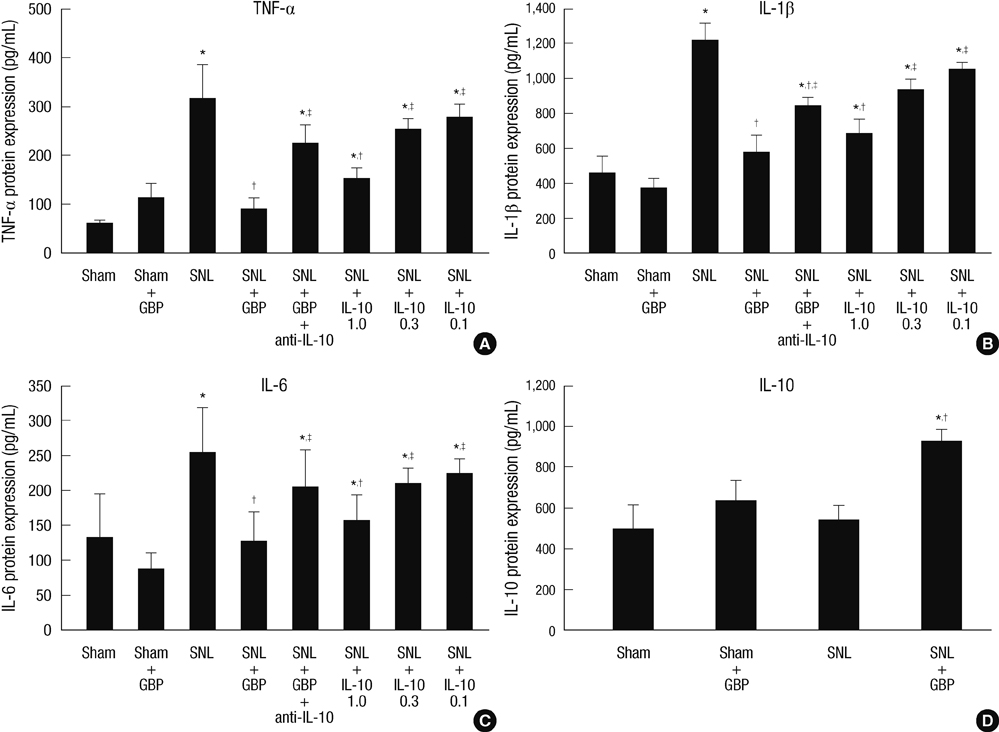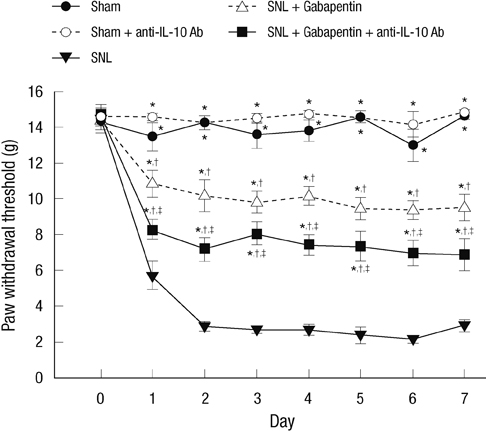J Korean Med Sci.
2013 Feb;28(2):308-314. 10.3346/jkms.2013.28.2.308.
Intrathecal Gabapentin Increases Interleukin-10 Expression and Inhibits Pro-Inflammatory Cytokine in a Rat Model of Neuropathic Pain
- Affiliations
-
- 1Department of Anesthesiology and Pain Medicine, CHA Medical Center, CHA University, Gumi, Korea.
- 2Department of Anesthesiology and Pain Medicine, Asan Medical Center, University of Ulsan College of Medicine, Seoul, Korea. jongyeon_park@amc.seoul.kr
- KMID: 1429210
- DOI: http://doi.org/10.3346/jkms.2013.28.2.308
Abstract
- We examined the possible anti-inflammatory mechanisms of gabapentin in the attenuation of neuropathic pain and the interaction between the anti-allodynic effects of gabapentin and interleukin-10 (IL-10) expression in a rat model of neuropathic pain. The anti-allodynic effect of intrathecal gabapentin was examined over a 7-day period. The anti-allodynic effects of IL-10 was measured, and the effects of anti-IL-10 antibody on the gabapentin were assessed. On day 7, the concentrations of pro-inflammatory cytokines and IL-10 were measured. Gabapentin produced an anti-allodynic effect over the 7-day period, reducing the expression of pro-inflammatory cytokines but increasing the expression of IL-10 (TNF-alpha, 316.0 +/- 69.7 pg/mL vs 88.8 +/- 24.4 pg/mL; IL-1beta, 1,212.9 +/- 104.5 vs 577.4 +/- 97.1 pg/mL; IL-6, 254.0 +/- 64.8 pg/mL vs 125.5 +/- 44.1 pg/mL; IL-10, 532.1 +/- 78.7 pg/mL vs 918.9 +/- 63.1 pg/mL). The suppressive effect of gabapentin on pro-inflammatory cytokine expression was partially blocked by the anti-IL-10 antibody. Expression of pro-inflammatory cytokines was significantly attenuated by daily injections of IL-10. The anti-allodynic effects of gabapentin may be caused by upregulation of IL-10 expression in the spinal cord, which leads to inhibition of the expression of pro-inflammatory cytokines in the spinal cords.
MeSH Terms
-
Amines/pharmacology/*therapeutic use
Analgesics/pharmacology/*therapeutic use
Animals
Antibodies/immunology/pharmacology
Behavior, Animal/drug effects
Cyclohexanecarboxylic Acids/pharmacology/*therapeutic use
Cytokines/*metabolism
Disease Models, Animal
Injections, Spinal
Interleukin-10/genetics/immunology/*metabolism
Male
Neuralgia/*drug therapy/metabolism/pathology
Rats
Rats, Sprague-Dawley
Recombinant Proteins/biosynthesis/genetics/pharmacology
Spinal Cord/metabolism
Up-Regulation
gamma-Aminobutyric Acid/pharmacology/*therapeutic use
Amines
Analgesics
Antibodies
Cyclohexanecarboxylic Acids
Cytokines
Recombinant Proteins
Interleukin-10
gamma-Aminobutyric Acid
Figure
Reference
-
1. Woolf CJ, Mannion RJ. Neuropathic pain: aetiology, symptoms, mechanisms and management. Lancet. 1999. 353:1959–1964.2. Kim SH, Chung JM. An experimental model for peripheral neuropathy produced by segmental spinal nerve ligation in the rat. Pain. 1992. 50:355–363.3. Sheen K, Chung JM. Signs of neuropathic pain depend on signals from injured nerve fibers in a rat model. Brain Res. 1993. 610:62–68.4. Kim KJ, Yoon YW, Chung JM. Comparison of three rodent neuropathic pain models. Exp Brain Res. 1997. 113:200–206.5. Raghavendra V, Rutkowski MD, DeLeo JA. The role of spinal neuroimmune activation in morphine tolerance/hyperalgesia in neuropathic and sham-operated rats. J Neurosci. 2002. 22:9980–9989.6. Tsai RY, Jang FL, Tai YH, Lin SL, Shen CH, Wong CS. Ultra-low-dose naloxone restores the antinociceptive effect of morphine and suppresses spinal neuroinflammation in PTX-treated rats. Neuropsychopharmacology. 2008. 33:2772–2782.7. del Rey A, Apkarian AV, Martina M, Besedovsky HO. Chronic neuropathic pain-like behavior and brain-borne IL-1β. Ann N Y Acad Sci. 2012. 1262:101–107.8. Kawasaki Y, Xu ZZ, Wang X, Park JY, Zhuang ZY, Tan PH, Gao YJ, Roy K, Corfas G, Lo EH, et al. Distinct roles of matrix metalloproteases in the early- and late-phase development of neuropathic pain. Nat Med. 2008. 14:331–336.9. Zhang JM, An J. Cytokines, inflammation, and pain. Int Anesthesiol Clin. 2007. 45:27–37.10. Vale ML, Marques JB, Moreira CA, Rocha FA, Ferreira SH, Poole S, Cunha FQ, Ribeiro RA. Antinociceptive effects of interleukin-4, -10, and -13 on the writhing response in mice and zymosan-induced knee joint incapacitation in rats. J Pharmacol Exp Ther. 2003. 304:102–108.11. Luo ZD, Calcutt NA, Higuera ES, Valder CR, Song YH, Svensson CI, Myers RR. Injury type-specific calcium channel α2δ-1 subunit up-regulation in rat neuropathic pain models correlates with antiallodynic effects of gabapentin. J Pharmacol Exp Ther. 2002. 303:1199–1205.12. Maneuf YP, Luo ZD, Lee K. α2δ and the mechanism of action of gabapentin in the treatment of pain. Semin Cell Dev Biol. 2006. 17:565–570.13. Backonja M, Beydoun A, Edwards KR, Schwartz SL, Fonseca V, Hes M, LaMoreaux L, Garofalo E. Gabapentin for the symptomatic treatment of painful neuropathy in patients with diabetes mellitus: a randomized controlled trial. JAMA. 1998. 280:1831–1836.14. Rowbotham M, Harden N, Stacey B, Bernstein P, Magnus-Miller L. Gabapentin for the treatment of postherpetic neuralgia: a randomized controlled trial. JAMA. 1998. 280:1837–1842.15. Bennett MI, Simpson KH. Gabapentin in the treatment of neuropathic pain. Palliat Med. 2004. 18:5–11.16. Chen SR, Pan HL. Effect of systemic and intrathecal gabapentin on allodynia in a new rat model of postherpetic neuralgia. Brain Res. 2005. 1042:108–113.17. Field MJ, Oles RJ, Lewis AS, McCleary S, Hughes J, Singh L. Gabapentin (neurontin) and S-(+)-3-isobutylgaba represent a novel class of selective antihyperalgesic agents. Br J Pharmacol. 1997. 121:1513–1522.18. Yaksh TL, Rudy TA. Chronic catheterization of the spinal subarachnoid space. Physiol Behav. 1976. 17:1031–1036.19. Park JY, Jun IG. The interaction of gabapentin and N6-(2-phenylisopropyl)-adenosine R-(-)isomer (R-PIA) on mechanical allodynia in rats with a spinal nerve ligation. J Korean Med Sci. 2008. 23:678–684.20. Lin SL, Tsai RY, Tai YH, Cherng CH, Wu CT, Yeh CC, Wong CS. Ultra-low dose naloxone upregulates interleukin-10 expression and suppresses neuroinflammation in morphine-tolerant rat spinal cords. Behav Brain Res. 2010. 207:30–36.21. Chaplan SR, Bach FW, Pogrel JW, Chung JM, Yaksh TL. Quantitative assessment of tactile allodynia in the rat paw. J Neurosci Methods. 1994. 53:55–63.22. Ma W, St-Jacques B, Duarte PC. Targeting pain mediators induced by injured nerve-derived COX2 and PGE2 to treat neuropathic pain. Expert Opin Ther Targets. 2012. 16:527–540.23. Chen YW, Li YT, Chen YC, Li ZY, Hung CH. Exercise training attenuates neuropathic pain and cytokine expression after chronic constriction injury of rat sciatic nerve. Anesth Analg. 2012. 114:1330–1337.24. Moalem G, Tracey DJ. Immune and inflammatory mechanisms in neuropathic pain. Brain Res Rev. 2006. 51:240–264.25. Fiorentino DF, Bond MW, Mosmann TR. Two types of mouse T helper cell. IV. Th2 clones secrete a factor that inhibits cytokine production by Th1 clones. J Exp Med. 1989. 170:2081–2095.26. Watkins LR, Hutchinson MR, Ledeboer A, Wieseler-Frank J, Milligan ED, Maier SF. Norman Cousins Lecture, Glia as the "bad guys": implications for improving clinical pain control and the clinical utility of opioids. Brain Behav Immun. 2007. 21:131–146.27. Milligan ED, Sloane EM, Langer SJ, Hughes TS, Jekich BM, Frank MG, Mahoney JH, Levkoff LH, Maier SF, Cruz PE, et al. Repeated intrathecal injections of plasmid DNA encoding interleukin-10 produce prolonged reversal of neuropathic pain. Pain. 2006. 126:294–308.28. Di Santo E, Sironi M, Pozzi P, Gnocchi P, Isetta AM, Delvaux A, Goldman M, Marchant A, Ghezzi P. Interleukin-10 inhibits lipopolysaccharide-induced tumor necrosis factor and interleukin-1 beta production in the brain without affecting the activation of the hypothalamus-pituitary-adrenal axis. Neuroimmunomodulation. 1995. 2:149–154.29. Inoue K. The function of microglia through purinergic receptors: neuropathic pain and cytokine release. Pharmacol Ther. 2006. 109:210–226.
- Full Text Links
- Actions
-
Cited
- CITED
-
- Close
- Share
- Similar articles
-
- The Combined Antiallodynic Effect of Gabapentin and Milnacipran in a Rat Neuropathic Pain Model
- The effect of inducing morphine tolerance on anti-allodynic action of gabapentin in spinal nerve-ligated rat
- Antihyperalgesic Effects of Intrathecal Gabapentin and CNQX, Non-NMDA Receptor Antagonist, in a Rat Model for Postoperative Pain
- Experience with Gabapentin for Neuropathic Pain
- Pharmacological interactions between intrathecal pregabalin plus tianeptine or clopidogrel in a rat model of neuropathic pain





